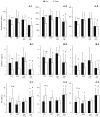High-intensity interval training and hypertension: maximizing the benefits of exercise?
- PMID: 22720199
- PMCID: PMC3371620
High-intensity interval training and hypertension: maximizing the benefits of exercise?
Abstract
Essential arterial hypertension is the most common risk factor for cardiovascular morbidity and mortality. Regular exercise is a well-established intervention for the prevention and treatment of hypertension. Continuous moderate-intensity exercise training (CMT) that can be sustained for 30 min or more has been traditionally recommended for hypertension prevention and treatment. On the other hand, several studies have shown that high-intensity interval training (HIT), which consists of several bouts of high-intensity exercise (~85% to 95% of HR(MAX) and/or VO(2MAX) lasting 1 to 4 min interspersed with intervals of rest or active recovery, is superior to CMT for improving cardiorespiratory fitness, endothelial function and its markers, insulin sensitivity, markers of sympathetic activity and arterial stiffness in hypertensive and normotensive at high familial risk for hypertension subjects. This compelling evidence suggesting larger beneficial effects of HIT for several factors involved in the pathophysiology of hypertension raises the hypothesis that HIT may be more effective for preventing and controlling hypertension.
Keywords: Exercise; arterial stiffness; autonomic nervous system; endothelial function; hypertension.
Figures





Similar articles
-
Effects of high-intensity aerobic interval training vs. moderate exercise on hemodynamic, metabolic and neuro-humoral abnormalities of young normotensive women at high familial risk for hypertension.Hypertens Res. 2010 Aug;33(8):836-43. doi: 10.1038/hr.2010.72. Epub 2010 May 7. Hypertens Res. 2010. PMID: 20448634 Clinical Trial.
-
Heart rate response to exercise and cardiorespiratory fitness of young women at high familial risk for hypertension: effects of interval vs continuous training.Eur J Cardiovasc Prev Rehabil. 2011 Dec;18(6):824-30. doi: 10.1177/1741826711398426. Epub 2011 Feb 28. Eur J Cardiovasc Prev Rehabil. 2011. PMID: 21450597 Clinical Trial.
-
Short-term high-intensity interval and continuous moderate-intensity training improve maximal aerobic power and diastolic filling during exercise.Eur J Appl Physiol. 2014 Feb;114(2):331-43. doi: 10.1007/s00421-013-2773-x. Epub 2013 Nov 27. Eur J Appl Physiol. 2014. PMID: 24281825
-
High-intensity interval training, solutions to the programming puzzle. Part II: anaerobic energy, neuromuscular load and practical applications.Sports Med. 2013 Oct;43(10):927-54. doi: 10.1007/s40279-013-0066-5. Sports Med. 2013. PMID: 23832851 Review.
-
The potential for high-intensity interval training to reduce cardiometabolic disease risk.Sports Med. 2012 Jun 1;42(6):489-509. doi: 10.2165/11630910-000000000-00000. Sports Med. 2012. PMID: 22587821 Review.
Cited by
-
Comparison of physiological and clinical markers for chronic sprint-interval training exercise performed either in the fasted or fed states among healthy adults.Curr Res Physiol. 2021 Sep 20;4:192-201. doi: 10.1016/j.crphys.2021.09.003. eCollection 2021. Curr Res Physiol. 2021. PMID: 34746838 Free PMC article.
-
Rating of perceived exertion as a tool for prescribing and self regulating interval training: a pilot study.Biol Sport. 2015 Jun;32(2):103-8. doi: 10.5604/20831862.1134312. Epub 2015 Jan 15. Biol Sport. 2015. PMID: 26028809 Free PMC article.
-
High-intensity Interval Training versus Continuous Exercise: Is There a Difference Regarding the Magnitude of Blood Pressure Reduction?Arq Bras Cardiol. 2020 Jul;115(1):15-16. doi: 10.36660/abc.20200261. Epub 2020 Aug 7. Arq Bras Cardiol. 2020. PMID: 32785495 Free PMC article. English, Portuguese. No abstract available.
-
The effect of exercise on blood pressure in chronic kidney disease: A systematic review and meta-analysis of randomized controlled trials.PLoS One. 2019 Feb 6;14(2):e0211032. doi: 10.1371/journal.pone.0211032. eCollection 2019. PLoS One. 2019. PMID: 30726242 Free PMC article.
-
Prevalence of Non-responders for Glucose Control Markers after 10 Weeks of High-Intensity Interval Training in Adult Women with Higher and Lower Insulin Resistance.Front Physiol. 2017 Jul 6;8:479. doi: 10.3389/fphys.2017.00479. eCollection 2017. Front Physiol. 2017. PMID: 28729841 Free PMC article.
References
-
- Chobanian AV, Bakris GL, Black HR, Cusnhiman WC, Green LA, Izzo JI Jr, Jones DW, Materson BJ, Oparil S, Wright JT Jr, Roccella EJ. National Heart, Lung, and Blood Institute Joint National Committee on Prevention, Detection, Evaluation, and Treatment of High Blood Pressure; National High Blood Pressure Education Program Coordinating Committee. The Seventh Report of the Joint National Committee on Prevention, Detection, Evaluation, and Treatment of High Blood Pressure. Hypertension. 2003;42:1206–1252. - PubMed
-
- Lawes CM, Vander Hoorn S, Rodgers A. Global burden of blood pressure-related disease, 2001. Lancet. 2008;371:1513–1518. - PubMed
-
- Lewington S, Clarke R, Qizilbash N, Peto R, Collins R. Age-specific relevance of usual blood pressure to vascular mortality: a meta-analysis of individual data for one million adults in 61 prospective studies. Lancet. 2002;360:1903–1913. - PubMed
-
- Haskell WL, Lee IM, Pate RR, Powell KE, Blair SN, Franklin BA, Macera CA, Heath GW, Thompson PD, Bauman A. Physical activity and public health: Updated recommendation for adults from the American College of Sports Medicine and the American Heart Association. Circulation. 2007;116:1081–1093. - PubMed
-
- American College of Sports Medicine. Position stand: exercise and hypertension. Med Sci Sports Exerc. 2004;36:533–553. - PubMed
LinkOut - more resources
Full Text Sources
Medical
